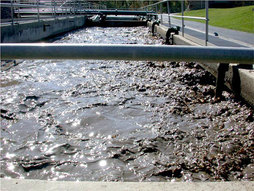 Aerobic Sludge Digester
Aerobic Sludge Digester Aerobic digesters with a 40 day retention time average 38 - 50% reduction in VSS compared to anaerobic digesters reducing VSS by 56 - 65% with a 30 day retention time. Just as important as solids reduction is improved dewatering/drying characteristics of the biosolids. Often organics such as grease and surfactants can create high levels of water and polysaccharides in the biosolids (floc). An efficient digester will act to continue the biological degradation of these compounds that was left incomplete in the main biological treatment unit.
With the high costs of removing water, handling, and disposing of biosolids, wastewater system engineers often look for ways to enhance solids destruction in the digester. Options include adding more aeration, mixers, and often "bioadditives". In bioadditives, I am lumping in both bioaugmentation cultures (i.e. bugs) and various enzyme or micronutrient products. The big question is ... can reduced sludge volume/mass justify the expense of adding these products?
While my company, Aster Bio, manufactures multiple biochemicals, I will say it all depends upon the makeup of the biosolids as to how well any product will help with the digester performance. In systems with high levels of entrained water or polysaccharides (biopolymers), the addition may very well give great results and easily justify the costs of addition. Other times, the improved dewatering properties may help reudce polymer usage or moisture in the solids which can justify the product cost. In all cases, we can screen the products using an aerated, temperature controlled lab test. This lab test should be done before committing to any full scale implementation.

 RSS Feed
RSS Feed